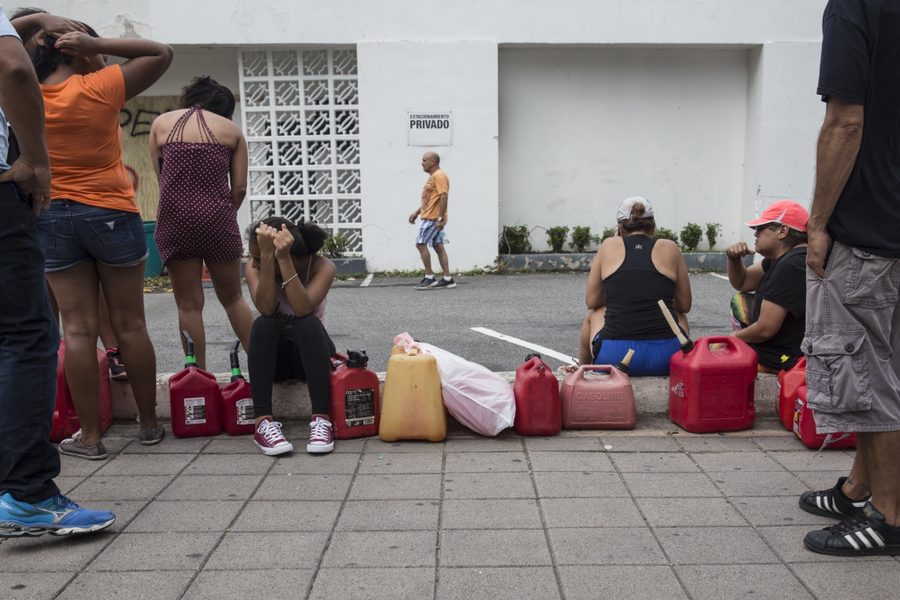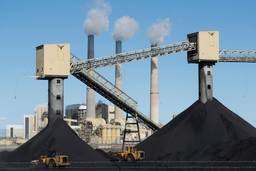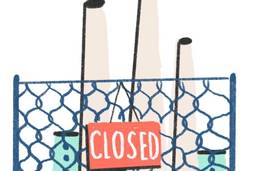How Puerto Rico Recovered Before
The island’s New Deal history offers an alternative to disaster capitalism.
Kate Aronoff

In the aftermath of the Great Depression, Puerto Rico was rebuilding in more ways than one. Aside from dealing with the impacts of a global financial crisis, the island had recently been battered by two massive storms: San Felipe II in 1928 and San Ciprian in 1932. The latter killed at least 257 people and destroyed more than 40,000 buildings. The former killed more people than Hurricane Katrina, and is still considered the second deadliest natural disaster in U.S. history, claiming the lives of up to 3,000 people in Florida and an estimated 300 people in Puerto Rico — and leaving as many as 500,000 Puerto Rican residents homeless. Puerto Rico’s agricultural economy — one of the island’s major sources of income — was decimated. In between the two storms was another: Black Tuesday.
As the continental United States would find when the depression set in, relief programs then consisted of a loose patchwork of private charities, faith-based aid and philanthropy. That patchwork was looser still in Puerto Rico. The corrective to that lack of infrastructure — the New Deal — was created by the Roosevelt Administration amid massive popular pressure, and the very real threat of a revolution. Lesser known is the fact that the program extended to Puerto Rico, also in response to pressure from the Left, and revolutionized everything from highways to education to public health.
As Puerto Ricans begin to rebuild in the wreckage of Hurricane Maria, the commonwealth’s experience with the New Deal offers an alternative path to the one likely to be put forward by the private interests currently swarming the island to build nests in the debris.
First, some background. Puerto Rico has been a territory of the United States since 1898 and a commonwealth since 1952, although many argue the relationship is more colonial than cooperative. Responding to the island’s persistent financial troubles, the United States placed Puerto Rico under the stewardship of a fiscal oversight board via the Puerto Rico Oversight, Management, and Economic Stability Act (PROMESA), passed into law by Congress last summer. Only one of the board’s seven members is required to maintain permanent residence in Puerto Rico, and its authority trumps that of both the island’s legislature and governor. The board has broad authority to break union contracts and sell off public assets, all in the name of getting Puerto Rico’s fiscal house in order. That body serves, too, as a kind of mediator between the people, the government of Puerto Rico and the largely U.S. investors — hedge and mutual funds and individuals — who hold the majority of Puerto Rico’s debt, thanks to a series of anachronistic tax cuts which incentivized bond buying even after those bonds’ ratings had been degraded to junk status. Essentially, the fiscal oversight board is pushing a slightly less drastic form of austerity than what bondholders are calling for: repayment as soon as possible, no matter the cost.
But this is hardly the first time Puerto Rico has been preyed upon by U.S. capital. In the lead-up to the New Deal, nearly half of Puerto Rico’s land — and most of its productive agricultural land — was owned by wealthy Americans. This phenomenon helped fuel a left-leaning populist movement among some of the island’s poorest residents. In part as a result of anger over U.S. ownership, each of the island’s four political parties collapsed between 1932 and 1940 as populism gained traction. Massive strikes rolled through the island as unemployment soared, and workers specifically targeted several U.S. corporations that had set up shop there. Such disputes often fused with demands for nationhood, and some of the period’s most influential labor leaders were prominent nationalists, like Pedro Albizu Campos. As New Dealer Rexford Tugwell put it at the time, “The materials for a class war were all present.”
In response to pressures in Puerto Rico and on the mainland, the Roosevelt Administration in 1935 created the Puerto Rico Reconstruction Administration (PRRA), which would last until 1955. The program replaced Puerto Rico Emergency Relief Administration (PRERA), instituted in 1933, and sought to address longer-term issues like infrastructure development and entrenched poverty.
“Before the PRRA, hurricane relief strategies created new slums,” wrote historian Geoff Burrows in his 2014 dissertation. “Without a comprehensive strategy for long-term economic development … hurricane housing relief built by the American Red Cross, PRERA, and local government was often an inadequate short-term solution to a problem that was guaranteed to repeat itself, given the geological and meteorological conditions of the Caribbean.”
PRRA went well beyond just recovery, aiming to spur economic growth and protect the island from the impacts of future storms. Burrows notes, “Efforts to build hurricane-proof infrastructure were integrated into a broader plan to improve life expectancy, economic opportunity and physical mobility for island citizens.”
“Taken together,” he adds, “the PRRA’s urban swamp-draining, slum clearance, cement-based housing construction, and rural rehabilitation housing programs aimed to halt the advance of several interrelated disease threats, buffer the island against the natural fury of tropical storms, and secure a lasting and permanent recovery from the Great Depression.”
By the late 1930s, Puerto Rico had the highest rate of school enrollment in its history, and had expanded electricity, sanitation and indoor plumbing to urban and rural parts of the island alike. For some parts of the commonwealth, the schools constructed by the PRRA were the first ever. Loans were granted for the creation of farming cooperatives for sugar and other crops, in some cases involving the reacquisition of private land; one farm owned by the absentee company American Suppliers was divided up into 461 small tobacco farms.
With an eye toward future storms, the PRRA worked with architects and engineers to construct thousands of concrete houses that could withstand hurricane-force winds — as many did just recently during Maria. Many of those structures were part of public housing projects meant to replace slums, with rents often well below $20 per month. One such development in San Juan, El Falansterio, included with rent “access to an interior patio, community building, kindergarten, a small library, with maintenance and janitorial services,” Burrows notes.
To do all this and more, the PRRA created massive numbers of jobs. Unemployment in 1934 had swelled to around 350,000 people, affecting an estimated three-quarters of the island. Four years later, the number of people unemployed had dropped to 150,000, with the program directly having put tends of thousands of people to work each year. In September 1936, there were 51,749 people working on PRRA projects.
For Tugwell, a main architect of several New Deal programs, Puerto Rico presented a chance to pursue more aggressive democratic planning than he had on the U.S. mainland. While several of the depression-relief programs pursued an ethos of “administration at the grassroots” — involving close coordination between federal administrators and local residents and officials — the New Deal in Puerto Rico was remarkable for how much autonomy was built in from the start. The entirety of the PRRA was administered locally, with several programs designed by Puerto Ricans. As Burrows recounts of the PRRA, “All projects, land acquisitions, infrastructural projects, and other capital investments were handed over in perpetuity to the ‘People of Puerto Rico’ to be locally owned and administered — regardless of future political status … these large transfers of properties and public works were not dependent on any future political or economic relationship with the United States.”
As was the case with most New Deal programs, the PRRA was not without its flaws, ranging from underfunding to incomplete goals to allegations of corruption. Yet, this history underscores that — in the coming days, weeks and months — Puerto Rico faces two potential paths to recovery. The United States could prioritize the alleviation of human suffering and fortification of local democracy, investing in things that made Puerto Rico more resilient in the long-term. The other scenario — which is much more likely — could see large swaths of the island’s public sphere sold off to private developers by order of the PROMESA-installed board, as the island’s economic fortunes continue to dwindle.
In July, the consultancy McKinsey & Co. entered into a contract with the fiscal oversight board to, among other things, draw up “detailed privatization/corporatization plans” for both PREPA and the Highways and Transportation Authority. Oversight board chairman José Carrión stated in the lead-up to Maria that he and his colleagues intended to invoke Title V of PROMESA, which allows for an expedited permitting process for private development projects during a state of emergency. Meanwhile, the U.S. president also seems to care more about chastising athletes than the rolling humanitarian crisis that 3.5 million U.S. citizens are now living through, targeting black and brown Americans for peaceful dissent on the mainland while leaving Puerto Ricans to die.
Despite the fiscal control board’s arguments to the contrary, there’s no reason why austerity has to define how Puerto Rico responds to the overlapping crises it faces today. Vulture capitalists are likely going to get creative during Maria recovery efforts, even more so given the relative media silence surrounding the storm’s devastating impacts on the island. Their opponents can do the same, and let the PRRA serve as an inspiration.
Kate Aronoff is a staff writer at The New Republic and author of Overheated: How Capitalism Broke the Planet — And How We Fight Back. She is co-author of A Planet To Win: Why We Need a Green New Deal and co-editor of We Own the Future: Democratic Socialism—American Style. Follow her on Twitter @katearonoff.








